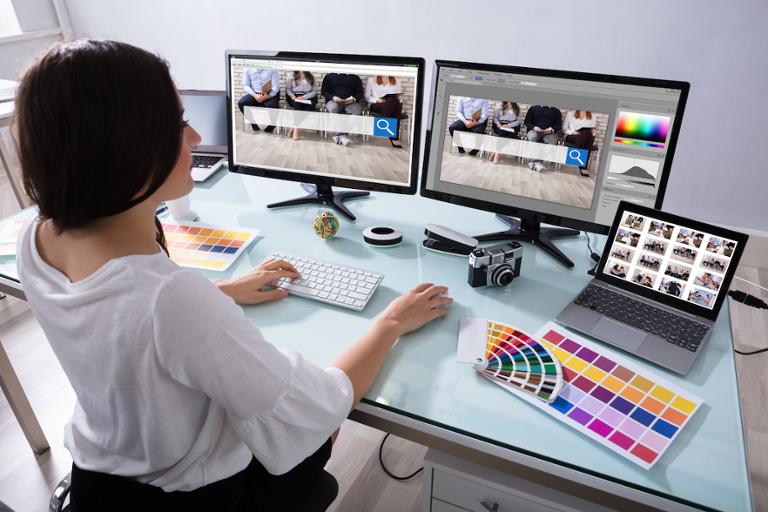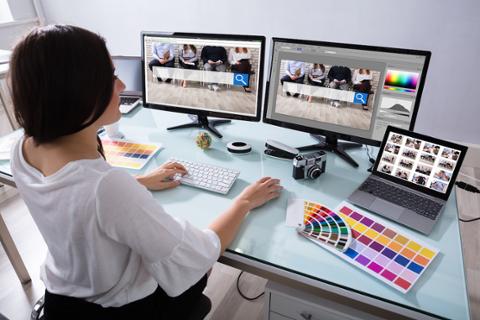At first glance, graphic design seems to be a moderately competitive field, with projected job growth of three percent between 2020 and 2030. Within tech, however, graphic design can prove a complex and ultra-competitive position, especially for jobs at top companies working on interesting projects. With that in mind, let’s break down an ideal graphic designer template, and show how you can optimize your application.
No matter what your career stage or aspirations, there are always ways to distinguish yourself from the competition when creating your graphic designer resume. “It’s important to showcase what you can do by applying the principles of graphic design to brand yourself both visually and verbally when creating your resume,” explained Evelyn Salvador, certified resume writer, personal branding pioneer and author of numerous resume and career books.
In this guide, we’ll cover the major steps to creating an effective resume, as well as delve into some of the things hiring managers want in a graphic designer. Remember, an ideal graphic designer resume will show how you can communicate in ways that inspire, inform and captivate audiences.
Characteristics of an Effective Graphic Designer Resume
Simply listing the things you can do on your resume doesn’t offer value to a prospective employer, Salvador said. Hiring managers want to know how you can apply your skills in ways that deliver results and ROI. That’s where a personal brand comes in.
To uncover the five critical components of an effective personal brand, Salvador asks clients the following questions:
What are your greatest assets and features? The qualities, attributes, skills and know-how you possess that can be useful to your target audience.
What are your greatest benefits? The ways in which your assets help a prospective employer such as attracting customers, boosting sales, generating profits, etc.
What is your competitive edge? Your strengths or the things that make you unique and stand out over others.
What is your value proposition? The total worth of the benefits you offer to a prospective employer, backed by matching achievements.
What is your ROI? The measurement (cost savings, revenue) of your contributions to a target audience.
She then weaves the key items into a marketing or personal branding statement. For graphic designers, tying in your past projects to overall company success is vital; for example, if you have a history of designing e-books that drew enormous engagement, or interfaces that led to an uptick in app user satisfaction, you should highlight that.
Showcase Your Brand Through Words, Images and Design
Once your brand has been identified and defined, the messaging needs to be conveyed throughout your resume using words, images and design.
While creative professionals may occasionally need a plain text resume or Word document to make it past screening software when applying for jobs online, Salvador recommends creating both a plain text and a hybrid or modified infographic version that incorporates simple, visual branding elements. If you follow her tips and submit your resume as a PDF it should make it through an applicant tracking system (ATS) and impress human reviewers.
For instance, inserting small graphics or logos in the header of your résumé and adding color or a border design can help further your brand and identity, and add visual appeal without impacting the ATS score. Consider selecting or designing your own graphic layout or using scanned samples of your work as a border. Designing your own occupational icon can also yield results.
Also, because most ATS will read the page from left to right, Salvador likes to include either a list of key skills and competencies, a mission statement, or three or four brief skill-related testimonials in a narrow left-handed column when creating résumés for creative professionals. In a competitive environment, testimonials and endorsements offer proof and give your resume an edge over other candidates (more examples of creative resumes here).
Creating a Professional Summary
Graphic artists should consider creating a headline slogan or tagline for the top of their resume (and other marketing materials) in addition to a profile summary that hones in on what an employer is looking for. Here are some examples:
- “Award-Winning Graphic Designer”
- “Versatile Graphic Designer Bringing Ideas to Life”
- "Graphic Designer — Creator of Compelling Designs that Drive Conversion Rates”
- “Graphic Designer with 5+ Years of Experience Creating Memorable Designs”
A summary should dig more into what makes a graphic designer unique. For example:
“A proven designer with creative and conceptual skills, exceptional attention to detail and a unique approach to storytelling that engages, transforms and inspires.”
Or you could go slightly longer:
“Offering a solid understanding of marketing principles and advertising techniques and more than seven years of experience developing designs for print media, online websites, video and advertising. Committed to developing a brand that matches your voice and your needs.”
How to Write a Professional Experience Summary
Work experience is another critical section of a graphic designer resume because it connects the dots between your prior projects, your technical and soft skills, and the role you’re pursuing. In addition to supporting your brand and bringing your resume to life, it should give the reviewer an idea of how you approach projects, who you’ve worked with, the skills you used, and the results you achieved.
To help the reviewer understand your creations and the value your offer, under a brief description of each position, describe two to three key projects using the CAR scheme:
- What was the challenge or goal of the project?
- What action did you take?
- What was the result?
Here are some examples:
- Conceptualized, designed and created digital pieces for real estate agents across the West to attract new listings, increasing customer interest and inquiries by 15%.
- Collaborated with vendor and top agent panel to create a coordinated email and social media campaign increasing click throughs by 10%, Facebook followers by 20% and Twitter followers by 5%.
- Designed signage, tradeshow banners and advertising graphics from concept through completion to effectively convey honesty, integrity and to differentiate agents in a crowded field. Several agents were recognized for their ethical standards, professionalism and contributions to their industry over the past year.
Final Tips and Characteristics of an Effective Developer Résumé
To further highlight and validate your design skills, create a project addendum or one-page gallery featuring photos and samples of your best work and either email it to the hiring manager or use it as a “leave behind” after interviews. This is in addition to your own online design portfolio. Also:
Match the job description: To capture the attention of automated and human reviewers, make simple modifications/customizations to match the requirements in the job description—including the hard and soft skills, types of design, mediums and the organizational culture—before hitting ‘Send.’ Even better, use a free tool like Jobscan or Résumé Worded to compare your résumé to a specific job description, make changes, add the right keywords, and get past applicant tracking systems.
Provide a skills summary or toolbox: When technical skills are necessary for performing typical tasks, provide a summary of your skills and show how you applied them in your work experience summary.
Be sure to include hot certifications and coursework: You should include top certifications and coursework that demonstrate expertise in must-have technologies and a passion for continuous learning. (In addition, more specialization and skills will allow you to potentially negotiate for a higher salary.)
Sign Up Today
Membership has its benefits. Sign up for a free Dice profile, add your resume, discover great career insights and set your tech career in motion. Register now



